文艺复兴英文资料
- 格式:docx
- 大小:21.55 KB
- 文档页数:3
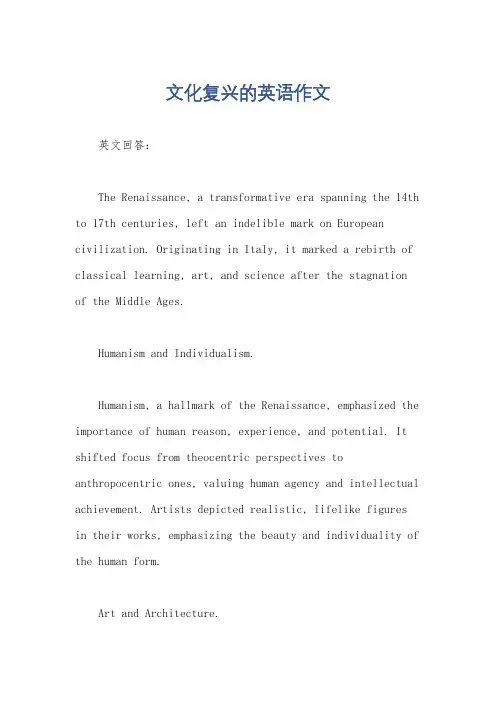
文化复兴的英语作文英文回答:The Renaissance, a transformative era spanning the 14th to 17th centuries, left an indelible mark on European civilization. Originating in Italy, it marked a rebirth of classical learning, art, and science after the stagnation of the Middle Ages.Humanism and Individualism.Humanism, a hallmark of the Renaissance, emphasized the importance of human reason, experience, and potential. It shifted focus from theocentric perspectives to anthropocentric ones, valuing human agency and intellectual achievement. Artists depicted realistic, lifelike figuresin their works, emphasizing the beauty and individuality of the human form.Art and Architecture.The Renaissance witnessed a burst of creative genius in the arts. Leonardo da Vinci, Michelangelo, and Raphael emerged as masters of painting and sculpture, their works capturing the essence of human emotion and anatomy. Architects like Brunelleschi and Alberti revived classical ideals in designing magnificent buildings, domes, and churches.Science and Exploration.The spirit of inquiry and experimentation permeated the Renaissance scientific sphere. Nicolaus Copernicus proposed a heliocentric model of the solar system, revolutionizing astronomy. Explorers like Christopher Columbus and Vasco da Gama embarked on daring voyages of discovery, expanding European horizons and fostering global trade.The Printing Press.The invention of the printing press by Johannes Gutenberg in the 15th century had a profound impact on theRenaissance. It facilitated the widespread dissemination of knowledge and ideas, empowering the masses with access to information and education.Social and Political Change.The Renaissance coincided with significant social and political transformations. The rise of wealthy merchant families in urban centers led to the growth of capitalism and the patronage of the arts. However, religious and political conflicts, such as the Protestant Reformation, also marked this period.Legacy of the Renaissance.The Renaissance laid the foundation for the scientific revolution, the Enlightenment, and the modern world. It ignited a passion for learning, creativity, and human potential that continues to inspire societies today.中文回答:文艺复兴,一个跨越14世纪至17世纪的变革时代,为欧洲文明留下了不可磨灭的印记。
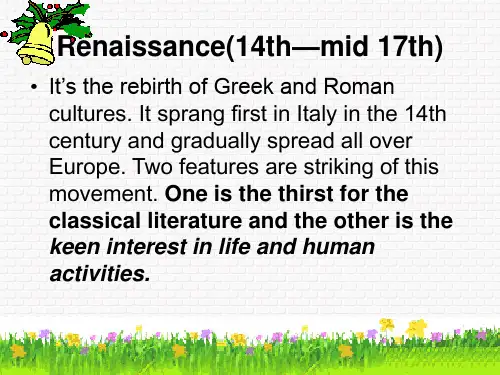
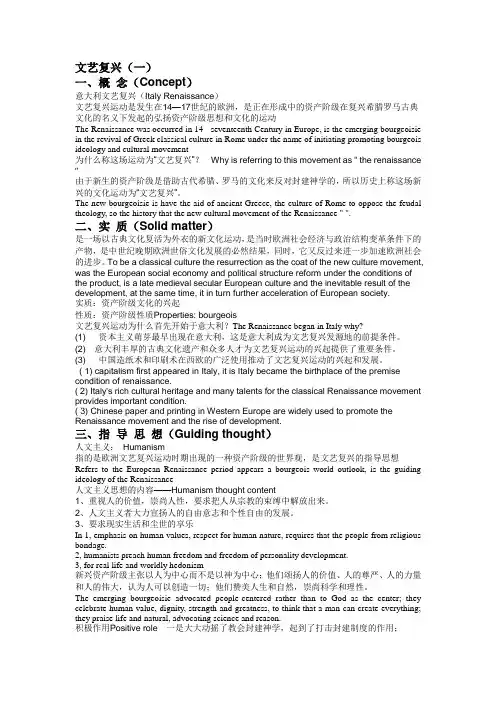
文艺复兴(一)一、概念(Concept)意大利文艺复兴(Italy Renaissance)文艺复兴运动是发生在14—17世纪的欧洲,是正在形成中的资产阶级在复兴希腊罗马古典文化的名义下发起的弘扬资产阶级思想和文化的运动The Renaissance was occurred in 14 - seventeenth Century in Europe, is the emerging bourgeoisie in the revival of Greek classical culture in Rome under the name of initiating promoting bourgeois ideology and cultural movement为什么称这场运动为“文艺复兴”?Why is referring to this movement as " the renaissance "由于新生的资产阶级是借助古代希腊、罗马的文化来反对封建神学的,所以历史上称这场新兴的文化运动为“文艺复兴”。
The new bourgeoisie is have the aid of ancient Greece, the culture of Rome to oppose the feudal theology, so the history that the new cultural movement of the Renaissance " ".二、实质(Solid matter)是一场以古典文化复活为外衣的新文化运动,是当时欧洲社会经济与政治结构变革条件下的产物,是中世纪晚期欧洲世俗文化发展的必然结果,同时,它又反过来进一步加速欧洲社会的进步。
To be a classical culture the resurrection as the coat of the new culture movement, was the European social economy and political structure reform under the conditions of the product, is a late medieval secular European culture and the inevitable result of the development, at the same time, it in turn further acceleration of European society.实质:资产阶级文化的兴起性质:资产阶级性质Properties: bourgeois文艺复兴运动为什么首先开始于意大利?The Renaissance began in Italy why?(1) 资本主义萌芽最早出现在意大利,这是意大利成为文艺复兴发源地的前提条件。
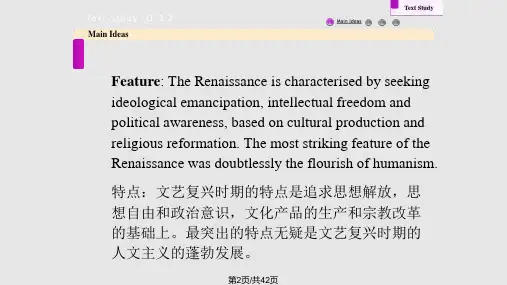
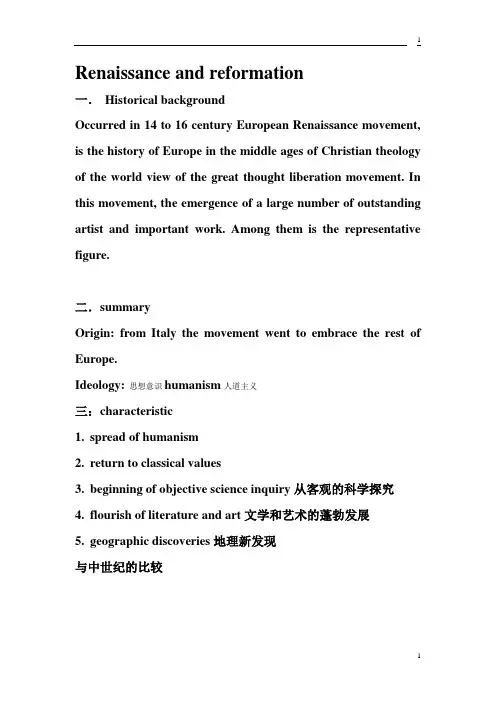
Renaissance and reformation一.Historical backgroundOccurred in 14 to 16 century European Renaissance movement, is the history of Europe in the middle ages of Christian theology of the world view of the great thought liberation movement. In this movement, the emergence of a large number of outstanding artist and important work. Among them is the representative figure.二.summaryOrigin: from Italy the movement went to embrace the rest of Europe.Ideology:思想意识humanism人道主义三:characteristic1.spread of humanism2.return to classical values3.beginning of objective science inquiry从客观的科学探究4.flourish of literature and art文学和艺术的蓬勃发展5.geographic discoveries地理新发现与中世纪的比较Renaissance Middle Ages ●European crisis in the late Middle Ages 在中世纪后期的欧洲经济危机●Humanism---a new attitude developed towards the human being---Giannozzo Manetti (1396-1459) On the Dignity of Man---value, spirit, life, happiness of human being---free will and free choice---believe in knowledge重点讲解:Renaissance Art16 century Italian Renaissance painting art interest on mature, and its representative painters are: Leonardo da Vinci , Michelangelo and Raphael.Dante, Francesco Petrarca, Boccaccio they are the pioneers of the Renaissance, known as the “Renaissance three massive stars”.a. Early renaissance ArtistsRaphael 拉斐尔 Leonardo Da Vinci 达芬奇 Michelangelo 米开朗基罗b. High renaissance artistsMichelangeloMichelangelo was Italian sculptor , painter architect and poet. He was a towering figure of the Renaissance . His drawings were influenced by Giotto and his sculpture showed the influence of DonatelloDavidDavid,a sculpture, It was the result of his studies in Rome ofancient sculpture总结:The Renaissance was Western Europe in modern history a great spiritual revolution. It to western painting art and the whole art field, has great impact.The Renaissance is the banner of a profound thought liberation movement. It makes sure of people on real life value and status, respects for the feelings of person, the power of praise. Against religion to mental shackles and thought shackled.Advocate the scientific spirits, pursuing the truth and knowledge,against ignorance and false theological concepts.。
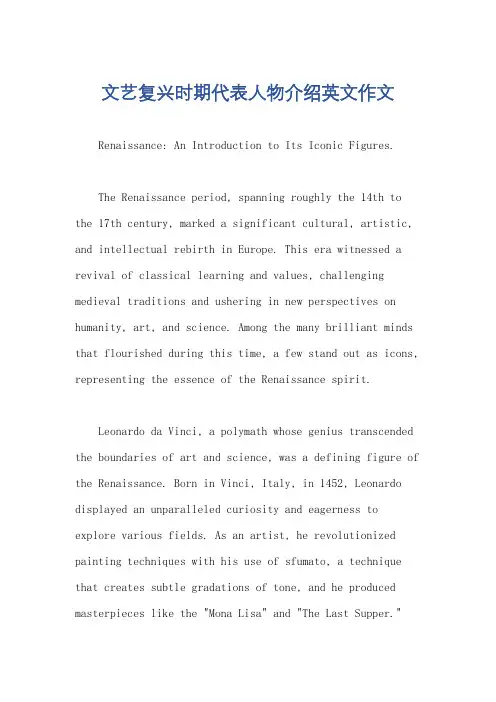
文艺复兴时期代表人物介绍英文作文Renaissance: An Introduction to Its Iconic Figures.The Renaissance period, spanning roughly the 14th to the 17th century, marked a significant cultural, artistic, and intellectual rebirth in Europe. This era witnessed a revival of classical learning and values, challenging medieval traditions and ushering in new perspectives on humanity, art, and science. Among the many brilliant minds that flourished during this time, a few stand out as icons, representing the essence of the Renaissance spirit.Leonardo da Vinci, a polymath whose genius transcended the boundaries of art and science, was a defining figure of the Renaissance. Born in Vinci, Italy, in 1452, Leonardo displayed an unparalleled curiosity and eagerness to explore various fields. As an artist, he revolutionized painting techniques with his use of sfumato, a technique that creates subtle gradations of tone, and he produced masterpieces like the "Mona Lisa" and "The Last Supper."However, Leonardo's achievements were not limited to the canvas. He made significant contributions to anatomy, mechanics, and engineering, designing innovative machines and studying the human body with unprecedented rigor. His notebooks, filled with sketches, diagrams.。
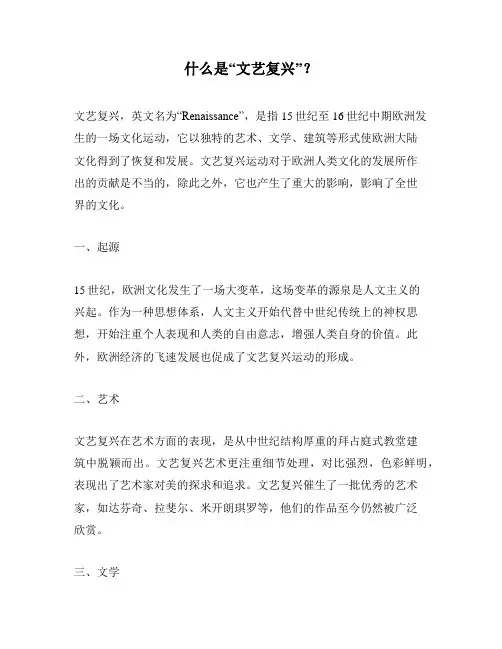
什么是“文艺复兴”?文艺复兴,英文名为“Renaissance”,是指15世纪至16世纪中期欧洲发生的一场文化运动,它以独特的艺术、文学、建筑等形式使欧洲大陆文化得到了恢复和发展。
文艺复兴运动对于欧洲人类文化的发展所作出的贡献是不当的,除此之外,它也产生了重大的影响,影响了全世界的文化。
一、起源15世纪,欧洲文化发生了一场大变革,这场变革的源泉是人文主义的兴起。
作为一种思想体系,人文主义开始代替中世纪传统上的神权思想,开始注重个人表现和人类的自由意志,增强人类自身的价值。
此外,欧洲经济的飞速发展也促成了文艺复兴运动的形成。
二、艺术文艺复兴在艺术方面的表现,是从中世纪结构厚重的拜占庭式教堂建筑中脱颖而出。
文艺复兴艺术更注重细节处理,对比强烈,色彩鲜明,表现出了艺术家对美的探求和追求。
文艺复兴催生了一批优秀的艺术家,如达芬奇、拉斐尔、米开朗琪罗等,他们的作品至今仍然被广泛欣赏。
三、文学文艺复兴时期文学的主要特点是逐渐从宗教哲学中解放出来,更注重现实和人类自身的表现。
代表作品有莎士比亚的《哈姆雷特》、《麦克白》等,莫里哀的《唐璜》等。
这些作品不仅是欧洲文学的经典之作,同时也影响了全球的文学发展。
四、思想文艺复兴对于思想的解放也起到了重要作用。
文艺复兴时期的人们主张人类的自由意志,遵循理性和科学知识体系,表现出对于世界的创造性和进取心。
文艺复兴对于人类思想和思维方式的改变产生了深远的影响。
五、结语文艺复兴是欧洲文化历史上的一段伟大时期,它的兴起不仅推动了欧洲文化的恢复和发展,同时也改变了人类的思想方式和思考方式。
文艺复兴让人们认识到艺术与文化对于人类发展的重要作用,激励人们对美好生活的追求和创造。
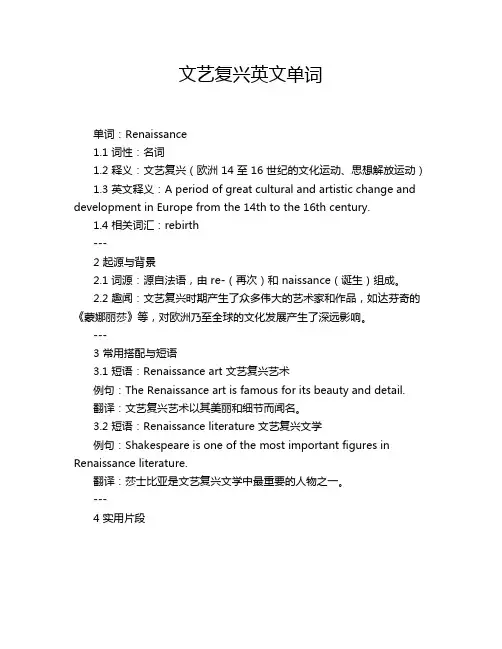
文艺复兴英文单词单词:Renaissance1.1 词性:名词1.2 释义:文艺复兴(欧洲 14 至 16 世纪的文化运动、思想解放运动)1.3 英文释义:A period of great cultural and artistic change and development in Europe from the 14th to the 16th century.1.4 相关词汇:rebirth---2 起源与背景2.1 词源:源自法语,由 re-(再次)和 naissance(诞生)组成。
2.2 趣闻:文艺复兴时期产生了众多伟大的艺术家和作品,如达芬奇的《蒙娜丽莎》等,对欧洲乃至全球的文化发展产生了深远影响。
---3 常用搭配与短语3.1 短语:Renaissance art 文艺复兴艺术例句:The Renaissance art is famous for its beauty and detail.翻译:文艺复兴艺术以其美丽和细节而闻名。
3.2 短语:Renaissance literature 文艺复兴文学例句:Shakespeare is one of the most important figures in Renaissance literature.翻译:莎士比亚是文艺复兴文学中最重要的人物之一。
---4 实用片段(1) "I'm studying the Renaissance period in history class. It's so fascinating to learn about the great thinkers and artists of that time." said Tom. "Yes, the Renaissance was a time of great innovation and creativity." replied the teacher.翻译:“我在历史课上学习文艺复兴时期。
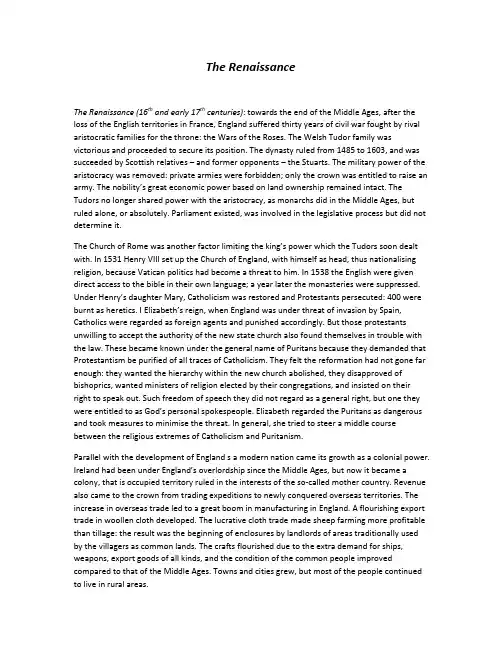
The RenaissanceThe Renaissance (16th and early 17th centuries): towards the end of the Middle Ages, after the loss of the English territories in France, England suffered thirty years of civil war fought by rival aristocratic families for the throne: the Wars of the Roses. The Welsh Tudor family was victorious and proceeded to secure its position. The dynasty ruled from 1485 to 1603, and was succeeded by Scottish relatives – and former opponents – the Stuarts. The military power of the aristocracy was removed: private armies were forbidden; only the crown was entitled to raise an army. The nobility’s great economic power based on land ownership remained intact. The Tudors no longer shared power with the aristocracy, as monarchs did in the Middle Ages, but ruled alone, or absolutely. Parliament existed, was involved in the legislative process but did not determine it.The Church of Rome was another factor limiting the king’s power which the Tudors soon dealt with. In 1531 Henry VIII set up the Church of England, with himself as head, thus nationalising religion, because Vatican politics had become a threat to him. In 1538 the English were given direct access to the bible in their own language; a year later the monasteries were suppressed. Under Henry’s daughte r Mary, Catholicism was restored and Protestants persecuted: 400 were burnt as heretics. I Elizabeth’s reign, when England was under threat of invasion by Spain, Catholics were regarded as foreign agents and punished accordingly. But those protestants unwilling to accept the authority of the new state church also found themselves in trouble with the law. These became known under the general name of Puritans because they demanded that Protestantism be purified of all traces of Catholicism. They felt the reformation had not gone far enough: they wanted the hierarchy within the new church abolished, they disapproved of bishoprics, wanted ministers of religion elected by their congregations, and insisted on their right to speak out. Such freedom of speech they did not regard as a general right, but one they were entitled to as God’s personal spokespeople. Elizabeth regarded the Puritans as dangerous and took measures to minimise the threat. In general, she tried to steer a middle course between the religious extremes of Catholicism and Puritanism.Parallel with the development of England s a modern nation came its growth as a colonial power. Ireland had been under England’s overlordship since the Middle Ages, but now it became a colony, that is occupied territory ruled in the interests of the so-called mother country. Revenue also came to the crown from trading expeditions to newly conquered overseas territories. The increase in overseas trade led to a great boom in manufacturing in England. A flourishing export trade in woollen cloth developed. The lucrative cloth trade made sheep farming more profitable than tillage: the result was the beginning of enclosures by landlords of areas traditionally used by the villagers as common lands. The crafts flourished due to the extra demand for ships, weapons, export goods of all kinds, and the condition of the common people improved compared to that of the Middle Ages. Towns and cities grew, but most of the people continued to live in rural areas.During the 16th and early 17th centuries, therefore, the people of England transformed the basis of their national and spiritual life. They also broadened their intellectual horizons and fashioned from a newly augmented language one of the great literatures of the western world. The period is known as the Renaissance; the term Renaissance (‘rebirth’) originally indicated a revival of classical (Greek and Roman) arts and sciences after the dark ages of medieval obscurantism. Renaissance writers returned to the classical sources of ‘humane letter’ in an attempt to find new ways of generating ideas and promoting a written and spoken eloquence greater in purity than the crabbed Latin of Medieval schoolmen.In line with the period’s enthusiasm for classical literature and art is a renewed b elief in humanism (a belief in human-based morality rather than in any supernatural authority). They believed, as Alexander Pope was to phrase it much later, that ‘the proper study of mankind is man’, rather than scholastic theology. For humanists the divi ne principle of reason was the guideline and that they found better realised in the classical world of antiquity than in the Middle Ages. They hoped to create a new civilisation in Europe at least equalling that of the old world. Thomas More wrote Utopia (1516) in which he puts forward his ideal of a future happy society. More’s book owes a considerable debt to Plato’s Republic and the Greek satirist Lucian. More’s topics include the corruption of the rich, the sufferings of the poor and the injustice of the death penalty for starving thieves. For More, only Utopia, where private property has been abolished, offers hope of an ideal state. The irony lies in the fact that utopia means ‘nowhere’. Utopia, however, provided a blueprint for a high-minded, money-free collective where a rational code is valued.Humanist ideals led to a widespread concern with education and many schools were formed, especially for boys who were educated in the faith of Christ and in classical literature (girls were for centuries deprived of a formal education). The study of Christian and pagan authors was seen as the best way to prepare men for the vicissitudes of life. Thus classical authors were studied as guides to life. An important aspect of the rhetorical training of the humanist schools in the Renaissance was the absorption of large numbers of received conventions or commonplaces of description (such as traditional similes) called topoi. All Renaissance students were taught, as part of their basic training, to amplify, vary, and enrich these topoi or received ideas in novel or copious ways. Shakespeare’s Sonnet 73 (1609) can be seen as a virtuoso example of this Renaissance rhetorical training in which the poem’s speaker attempts to persuade the addressee to regard him in a certain way. Each of the quatrains contains a different, extended metaphor for the speaker’s age or condition: (i) as late autumn, (ii) as twilight, (iii) as a dying fire. All three metaphors are commonplace ways, or received topoi, of representing old age, yet the interesting thing about the poem is that it revitalises these ‘old’ or ‘tired’ metaphors by extending them, and making them precise and specific rather than vaguely general.A further shaping influence on the literature of the period were the religious movements of the Reformation. The authority of the Catholic Church was no longer seen as infallible; indeed, ordinary individuals believed that they did not need the help of a priest to interpret scripture.Luther did not believe that the Catholic Church could save souls but that a man’s salvation depended on God’s grace and justification by faith alone. Private experience became the means of the deepest spiritual discovery. Reading scripture became more important than listening to a priest. There was a move here towards individualism.Both Protestantism and humanism had a formative influence on the genius of William Shakespeare. In common with other Elizabethan dramatists, his dramas broke away from the religious domination evident in the crypto-Catholic mystery and morality plays of the medieval era, and show an interest in the classics that is matched by a vivid social realism. Of all his dramas, the tragedies are generally regarded as Shakespeare’s supreme achievement. As in Greek tragedy, many of the main figures are kings and queens (e. g. Claudius and Gertrude in Hamlet); ordinary individuals are not yet considered appropriate vehicles for edification. However, we do not remember Hamlet because he is the king’s son but, rather, because of his personality. During the Tudor age the fate of a nation depended to a greater extent than in medieval times on the character of the rulers; it is therefore not surprising that drama produced the greatest literary individuals the stage had ever seen. The tragic fate of these individuals is not caused by external forces outside their control but is of their own making: their downfall is caused by specific features of character or weaknesses exposed under exceptional circumstances. Consider Hamlet’s inability to make up his mind, for example; a tragic flaw that led to his own death and the death of many innocent people. The tumultuous nature of his time had made Shakespeare acutely aware of the precariousness of fortune and character, and how quickly the veneer of civilisation could disintegrate under adverse conditions.Sonnet no. 73 (William Shakespeare)That time of year thou mayest in me beholdWhen yellow leaves, or none, or few, do hangUpon those boughs which shake against the cold,bare ruin'd choirs, where late the sweet birds sang.In me thou see'st the twilight of such dayAs after sunset fadeth in the west,Which by and by black night doth take away,Death's second self, that seals up all in rest.In me thou see'st the glowing of such fire,That on the ashes of his youth doth lie,As the death-bed whereon it must expireConsum'd with that which it was nourish'd by. This thou perceiv'st, which makes thy love more strong, To love that well which thou must leave ere long.(i)Identify the conceit and ‘Volta’ in Sonnet 73.。
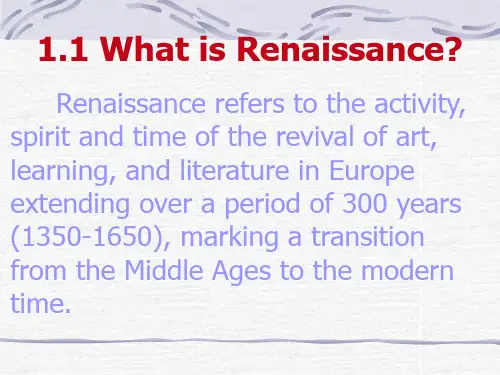
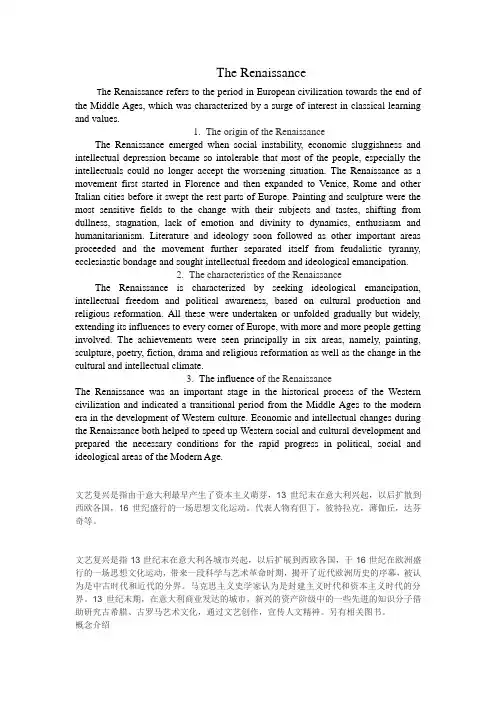
The RenaissanceT he Renaissance refers to the period in European civilization towards the end of the Middle Ages, which was characterized by a surge of interest in classical learning and values.1.The origin of the RenaissanceThe Renaissance emerged when social instability, economic sluggishness and intellectual depression became so intolerable that most of the people, especially the intellectuals could no longer accept the worsening situation. The Renaissance as a movement first started in Florence and then expanded to Venice, Rome and other Italian cities before it swept the rest parts of Europe. Painting and sculpture were the most sensitive fields to the change with their subjects and tastes, shifting from dullness, stagnation, lack of emotion and divinity to dynamics, enthusiasm and humanitarianism. Literature and ideology soon followed as other important areas proceeded and the movement further separated itself from feudalistic tyranny, ecclesiastic bondage and sought intellectual freedom and ideological emancipation.2.The characteristics of the RenaissanceThe Renaissance is characterized by seeking ideological emancipation, intellectual freedom and political awareness, based on cultural production and religious reformation. All these were undertaken or unfolded gradually but widely, extending its influences to every corner of Europe, with more and more people getting involved. The achievements were seen principally in six areas, namely, painting, sculpture, poetry, fiction, drama and religious reformation as well as the change in the cultural and intellectual climate.3.The influence of the RenaissanceThe Renaissance was an important stage in the historical process of the Western civilization and indicated a transitional period from the Middle Ages to the modern era in the development of Western culture. Economic and intellectual changes during the Renaissance both helped to speed up Western social and cultural development and prepared the necessary conditions for the rapid progress in political, social and ideological areas of the Modern Age.文艺复兴是指由于意大利最早产生了资本主义萌芽,13世纪末在意大利兴起,以后扩散到西欧各国,16世纪盛行的一场思想文化运动。
文艺复兴:The Renaissance era encompasses(围绕,包围)Western music history from 1400 to the beginning of the 1600. This period in time marked the rebirth of humanism, and the revival (复兴)of cultural achievements for their own sake in all forms of art, including music. The word "Renaissance" in itself is defined as a "rebirth" or a "reconstruction".During this time, artists and musicians produced works that displayed more artistic freedom and individualism. This creativity allowed artists to abandon the stricter ways of the Medieval(中古的,中世纪的)Era(纪元). Their art forms rediscovered the ancient Greek ideals. The great masters of the Renaissance were revered(崇敬,尊崇,敬畏)in their own lifetimes (rather than after their deaths), which was different from most of their Medieval predecessors. With the new printing techniques, music and musical ideas were able to be preserved and distributed to the people.莎士比亚:throne (王位,帝位)(1603) the troupe(剧团)was designated by the new king as the King's Men (or King's Company). The Letters Patent of the company specifically charged Shakespeare and eight others "freely to use and exercise the art and William Shakespeare was born to John Shakespeare and mother Mary Arden some time in late April 1564 in Stratford-upon-Avon. There is no record of his birth, but his baptism (火的洗礼,初次的不愉快)was recorded by the church, thus hisbirthday is assumed(假设的,设想的)to be the 23 of April. His father was a prominent and prosperous alderman(市议员)in the town of Stratford-upon-Avon, and was later granted a coat of arms by the College of Heralds. All that is known of Shakespeare's youth is that he presumably(据推测,大概,可能)attended the Stratford Grammar School, and did not proceed to Oxford or Cambridge. The next record we have of him is his marriage to Anne Hathaway in 1582. The next year she bore a daughter for him, Susanna, followed by the twins Judith and Hamlet two years later.Seven years later Shakespeare is recognized as an actor, poet and playwright, when a rival playwright(剧作家), Robert Greene, refers to him as "an upstart(暴发户,新贵,傲慢自负的人)crow(乌鸦)" in A Groatsworth of Wit. A few years later he joined up with one of the most successful acting troupe's(剧团)in London: The Lord Chamberlain's Men. When, in 1599, the troupe lost the lease of the theatre where they performed, (appropriately called The Theatre) they were wealthy enough to build their own theatre across the Thames(泰晤士河), south of London, which they called "The Globe." The new theatre opened in July of 1599, built from the timbers(横梁,木材)of The Theatre, with the motto "Totus mundus agit histrionem" (A whole world of players) When James I came to thfaculty of playing Comedies,Tragedies, Histories, Inerludes, Morals, Pastorals(牧函,主教教书), stage plays ... as well for recreation of our loving subjects as for our solace(安慰)and pleasure."概念隐喻In cognitive(认知的) linguistics, conceptual metaphor, or cognitive metaphor, refers to the understanding of one idea, or conceptual domain(领域), in terms of another, for example, understanding quantity in terms of directionality(方向性,定向性) (e.g. "price is rising"). A conceptual domain can be any coherent organization of human experience. The regularity with which different languages employ the same metaphors, which often appear to be perceptually(知觉的,有知觉的)based, has led to the hypothesis(假说,假设,前提)that the mapping between conceptual domains corresponds to(相当于)neural (神经的)mappings(映射,计划,绘制地图)in the brain (概念隐喻理论思想首先是在Lakoff & Johnson在《我们赖以生存的隐喻》一书中提出来的)明喻simileInfluenceSee also Literary influence of HamletHamlet is one of the most quoted works in the Englishlanguage, and is often included on lists of the world's greatest literature.[99] As such, it reverberates through the writing of later centuries. Academic Laurie Osborne identifies the directinfluence of Hamlet in numerous modern narratives, and divides them into four main categories: fictional accounts of the play's composition, simplifications of the story for young readers, stories expanding the role of one or more characters, and narratives featuring performances of the play.[100]Henry Fielding's Tom Jones, published about 1749, describes a visit to Hamlet by Tom Jones and Mr Partridge, with similarities to the "play within a play".[101] In contrast, Goethe's Bildungsroman Wilhelm Meister's Apprenticeship, written between 1776 and 1796, not only has a production of Hamlet at its core but also creates parallels between the Ghost and Wilhelm Meister's dead father.[101] In the early 1850s, in Pierre, Herman Melville focuses on a Hamlet-like character's long development as a writer.[101] Ten years later, Dickens's Great Expectations contains many Hamlet-like plot elements: it is driven by revenge-motivated actions, contains ghost-like characters (Abel Magwich and Miss Havisham), and focuses on the hero's guilt.[101] Academic Alexander Welsh notes that Great Expectations is an "autobiographical novel" and "anticipates psychoanalytic readings of Hamlet itself".[102] About the same time, George Eliot's The Mill on the Floss was published, introducing Maggie Tulliver "whois explicitly compared with Hamlet"[103] though "with a reputation for sanity".[104]In the 1920s, James Joyce managed "a more upbeat version" of Hamlet—stripped of obsession and revenge—in Ulysses, though its main parallels are with Homer's Odyssey.[101] In the 1990s, two women novelists were explicitly influencedby Hamlet. In Angela Carter's Wise Children, To be or not to be[105] is reworked as a song and dance routine, and Iris Murdoch's The Black Prince has Oedipal themes and murder intertwined with a love affair between a Hamlet-obsessed writer, Bradley Pearson, and the daughter of his rival.[103] There is the story of the woman who read Hamlet forthe first time and said, "I don't see why people admirethat play so. It is nothing but a bunch of quotationsstrung together."—Isaac Asimov, Asimov's Guide to Shakespeare, pg vii, Avenal Books, 1970。
文艺复兴英文介绍The Renaissance, a period in European history that spanned from the 14th to the 17th century, is oftenreferred to as the "rebirth" of art, culture, and learning. It was a time of great intellectual and artistic achievement, marked by a renewed interest in classical antiquity and a shift towards humanism. The Renaissance saw a revival of interest in literature, philosophy, science, and the arts, with scholars and artists looking back to the works of ancient Greece and Rome for inspiration.One of the defining characteristics of the Renaissance was the emergence of a new artistic style known as "Renaissance art." This style was characterized by a focus on realism, perspective, and human anatomy, as well as a greater emphasis on individualism and the portrayal of the human experience. Artists such as Leonardo da Vinci, Michelangelo, and Raphael are among the most famous figures of the Renaissance, known for their groundbreaking work in painting, sculpture, and architecture.In addition to the arts, the Renaissance also saw significant advancements in science and technology. The period witnessed the development of new scientific theories, such as those of Copernicus and Galileo, which challenged long-held beliefs about the universe and the natural world. The invention of the printing press by Johannes Gutenbergin the mid-15th century also played a crucial role in spreading knowledge and ideas throughout Europe, leading to an increase in literacy and the dissemination of new scientific and philosophical thought.The Renaissance was not just a period of artistic and intellectual achievement; it was also a time of political and social change. The rise of powerful city-states in Italy, such as Florence and Venice, led to a flourishing of trade and commerce, as well as the patronage of the arts by wealthy merchants and rulers. The printing press alsoplayed a role in the spread of new ideas and the rise of a more educated middle class, who began to questiontraditional authority and challenge established norms.Overall, the Renaissance was a transformative period in European history, characterized by a renewed interest in learning, a flourishing of the arts, and significant advancements in science and technology. It laid the foundation for the modern world, shaping the development of Western culture and thought in profound ways. The legacy of the Renaissance continues to influence our understanding of art, science, and society to this day, making it a pivotal moment in human history.。
1RenaissanceThe Renaissance (UK/rɨˈneɪsəns/, US/ˈrɛnɨsɑːns/)[1] is a period in Europe, from the 14th to the 17th century, considered the bridge between the Middle Ages and modern history. It started as a cultural movement in Italy in the Late Medieval period and later spread to the rest of Europe, marking the beginning of the Early Modern Age.The Renaissance's intellectual basis was humanism, derived from the rediscovery of classical Greek philosophy, such as that of Protagoras, who said, that "Man is the measure of all things." This new thinking became manifest in art, architecture, politics, science and literature. Early examples were the development of perspective in oil painting and the recycled knowledge of how to make concrete. Although the inventionof metal movable type sped the dissemination of ideas from the later 15th century, the changes of the Renaissance were not uniformly experienced across Europe.As a cultural movement, it encompassed innovative flowering of Latin and vernacular literatures, beginning with the 14th century resurgence of learning based on classical sources, which contemporaries credited to Petrarch; the development oflinear perspective and other techniques of rendering a more natural reality in painting; and gradual but widespread educational reform. In politics, the Renaissance contributed to the development of the customs and conventions of diplomacy, and in science to an increased reliance on observation and inductive reasoning. Although the Renaissance saw revolutions in many intellectual pursuits, as well as social and political upheaval, it is perhaps best known for its artistic developments and the contributions ofsuch polymaths as Leonardo da Vinci and Michelangelo, who inspired the term "Renaissance man".[2][3]There is a consensus that the Renaissance began in Florence, in the 14thcentury.[4] Various theories have been proposed to account for its origins and characteristics, focusing on a variety of factors including the social and civic peculiarities of Florence at the time; its political structure; the patronage of its dominant family,the Medici;[5][6] and the migration of Greek scholars and texts to Italy following the Fall of Constantinople at the hands of the Ottoman Turks.[7][8][9] Other major centres were northern Italian city-states such as Venice, Genoa, Bologna, Milan andfinally Rome during the Renaissance Papacy.The Renaissance has a long and complex historiography, and, in line with general scepticism of discrete periodizations, there has been much debate among historians reacting to the 19th-century glorification of the "Renaissance" and individual culture heroes as "Renaissance men", questioning the usefulness of Renaissance as a term andas a historical delineation.[10] The art historian Erwin Panofsky observed of this resistance to the concept of "Renaissance":It is perhaps no accident that the factuality of the Italian Renaissance has been most vigorously questioned by those who are not obliged to take a professional interest in the aesthetic aspects of civilization—historians of economic and social developments, political and religious situations, and, most particularly, natural science—but only exceptionally by students of literature and hardly ever by historians of Art.[11]Some observers have called into question whether the Renaissance was a cultural "advance" from the Middle Ages, instead seeing it as a period of pessimismand nostalgia for classical antiquity,[12] while social and economic historians, especially of the longue durée, have instead focused on the continuity between the two eras[13] which are linked, as Panofsky himself observed, "by a thousand ties".[14]The word Renaissance, literally meaning "Rebirth" in French, first appears in English in the 1830s.[15] The word occurs in Jules Michelet's 1855 work, Histoire de France. The word Renaissance has also been extended to other historical and cultural movements, such as the Carolingian Renaissance and the Renaissance of the 12th century.[16]2RepresentativesAlfred Tennyson, among many others. In addition, the first use of the interlockingthree-line rhyme scheme, or the terza rima, is attributed to him.Dante has been called "the Father of the Italian language".[2] In Italy, Dante is often referred to as il Sommo Poeta("the Supreme Poet") and il Poeta; he, Petrarch, and Boccaccio are also called "the three fountains" or "the three crowns".The Divine Comedy describes Dante's journeythrough Hell (Inferno), Purgatory (Purgatorio), and Paradise (Paradiso)Dante, like most Florentines of his day, was embroiled in the Guelph–Ghibelline conflict. He fought in the Battle of Campaldino (June 11, 1289), with the Florentine Guelphs against Arezzo Ghibellines; then in 1294 he was among the escorts of Charles Martel of Anjou (grandson of Charles I of Naples, more commonly called Charles of Anjou) while he was in Florence. To further his political career, he became a pharmacist. He did not intend to practice as one, but a law issued in 1295 required nobles aspiring to public office to be enrolled in one of the CorporazionidelleArti e deiMestieri, so Dante obtained admission to the Apothecaries' Guild. This profession was not inappropriate, since at that time books were sold from apothecaries' shops. As a politician he accomplished little, but held various offices over some years in a city rife with political unrest.After defeating the Ghibellines, the Guelphs divided into two factions: the White Guelphs (Guelfi Bianchi)—Dante's party, led by VierideiCerchi—and the Black Guelphs (GuelfiNeri), led by Corso Donati. Although the split was along family lines at first, ideological differences arose based on opposing views of the papal role in Florentine affairs, with the Blacks supporting the Pope and the Whites wanting more freedom from Rome. The Whites took power first and expelled the Blacks. In response, Pope Boniface VIII planned a military occupation of Florence. In 1301, Charles of Valois, brother ofKing Philip IV of France, was expected to visit Florence because the Pope had appointed him peacemaker for Tuscany. But the city's government had treated the Pope's ambassadors badly a few weeks before, seeking independence from papal influence. It was believed that Charles had received other unofficial instructions, so the council sent a delegation to Rome to ascertain the Pope's intentions. Dante was one of the delegates.2. Leonardo da Vinci。